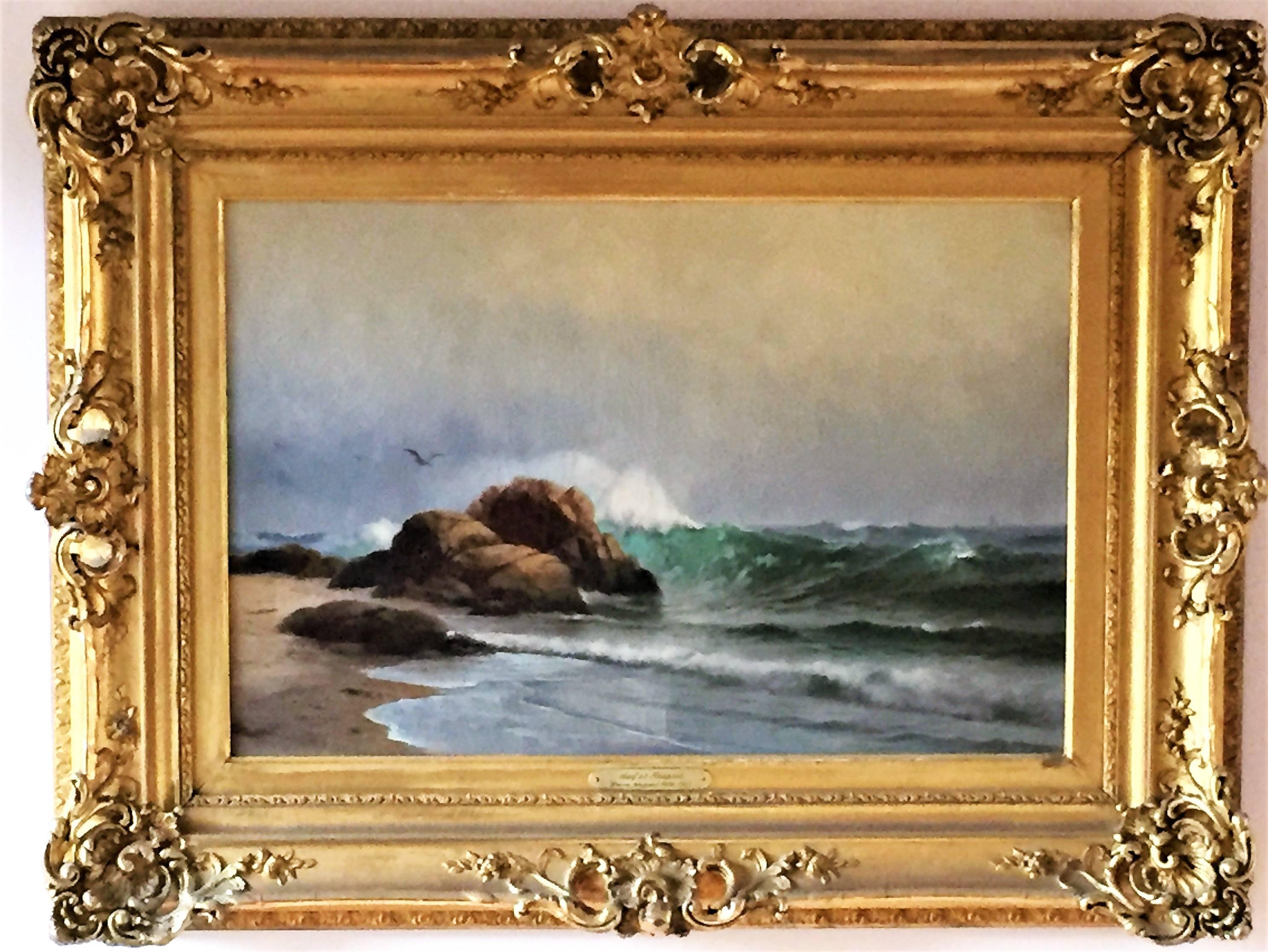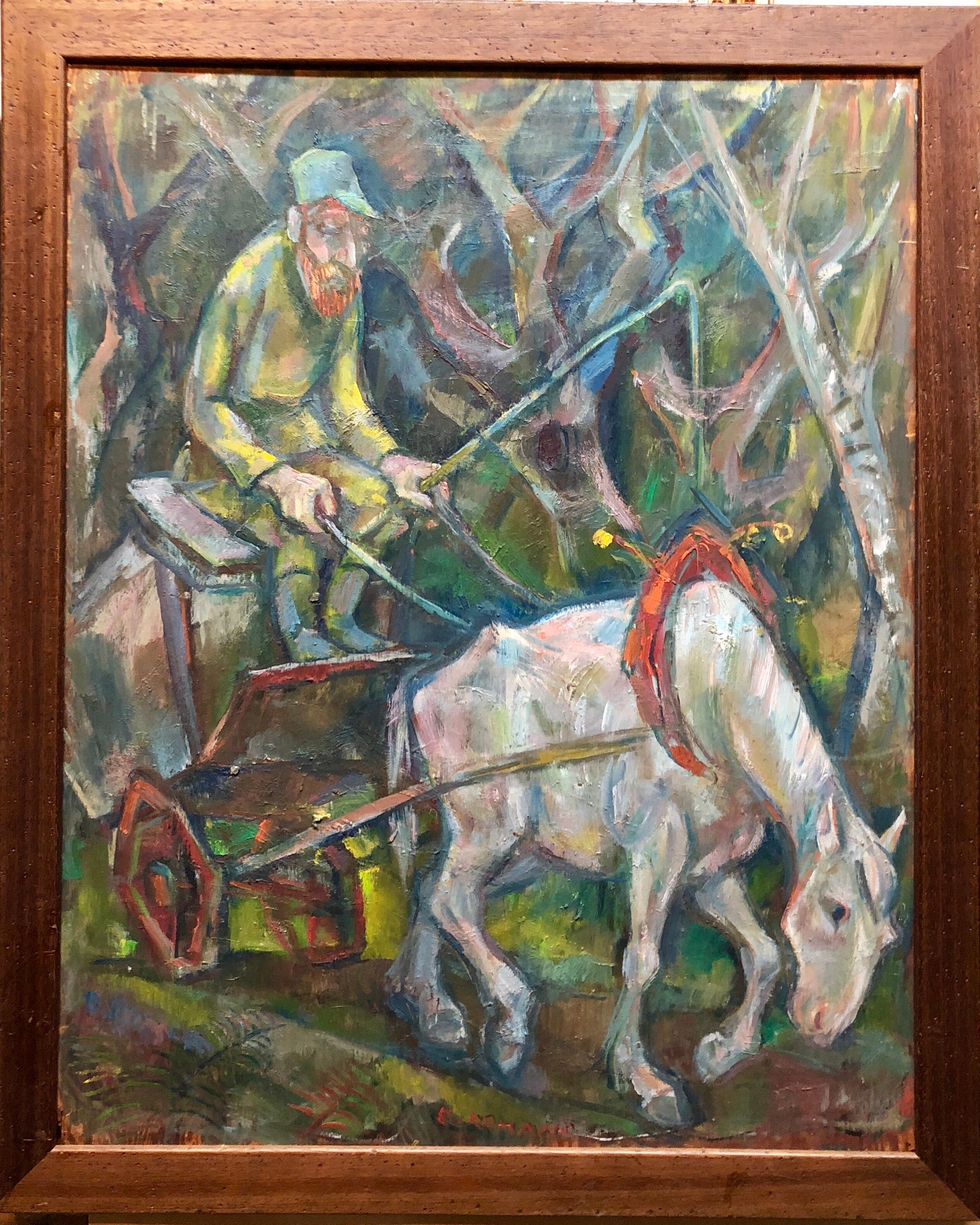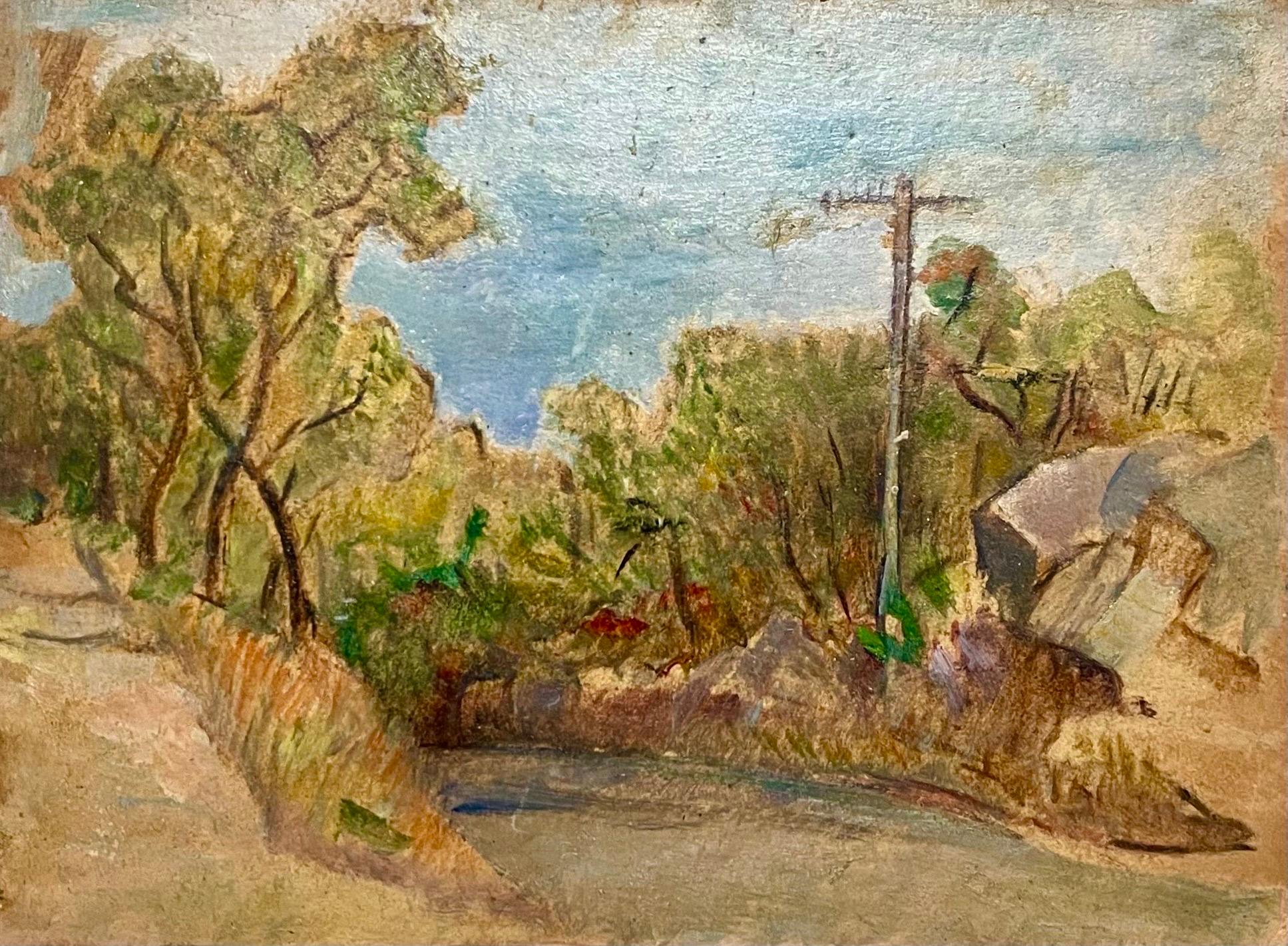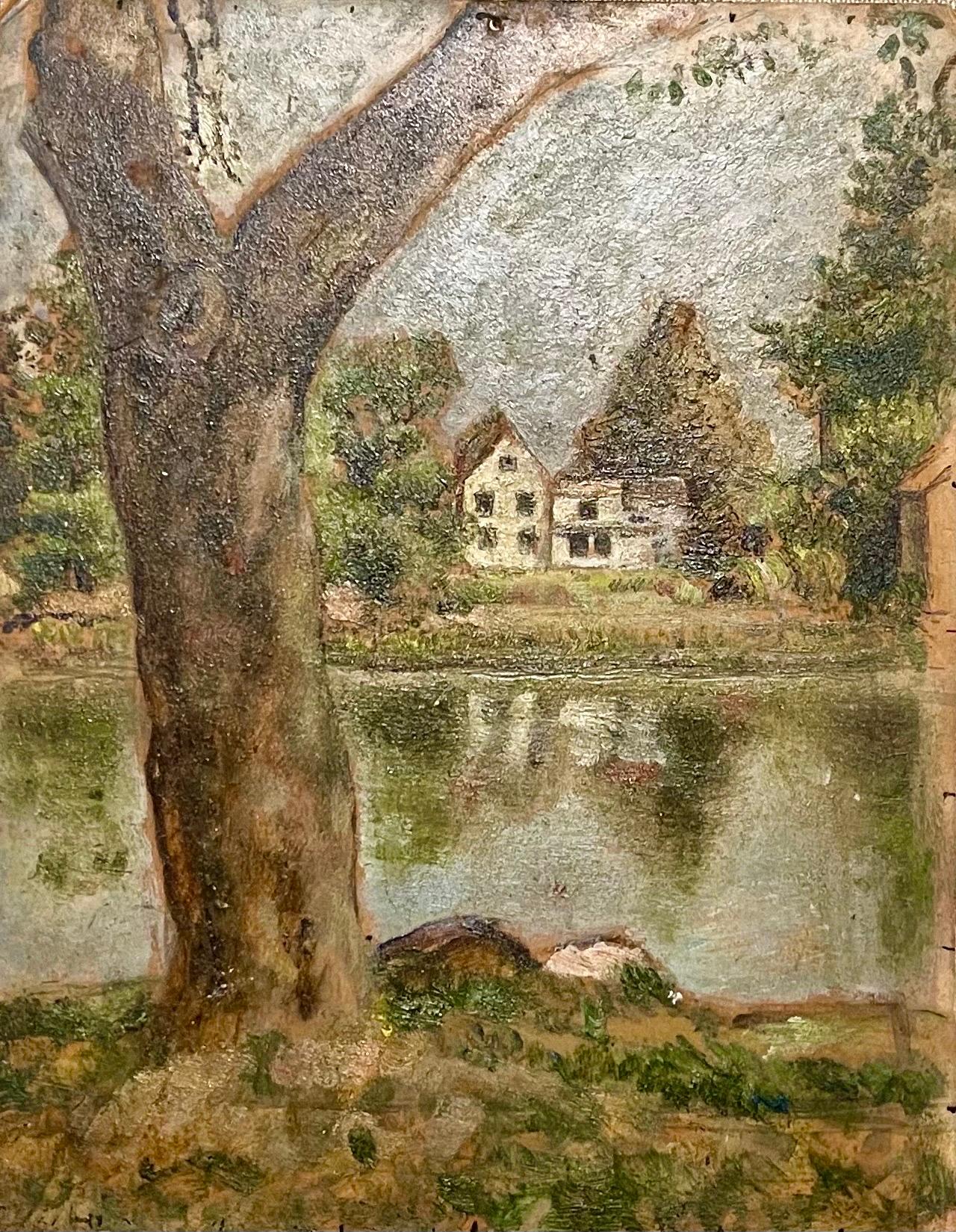Items Similar to Mountain Landscape, Springtime, New Mexico
Want more images or videos?
Request additional images or videos from the seller
1 of 8
Russell CowlesMountain Landscape, Springtime, New Mexico1937
1937
About the Item
Russell Cowles
American, 1887-1979
Mountain Landscape, Springtime, New Mexico
Oil on board
24 by 30 in. W/frame 30 ¼ by 36 ¼ in.
Signed lower right
Russell Cowles was born in Algona, Iowa in 1887. His father was a well-known newspaperman, who became publisher of the Des Moines Register and Tribune. His mother studied art at the Art Institute of Chicago and encouraged his interest. He graduated from Dartmouth in 1909 and studied in Paris as well as New York at the National Academy of Design and the Art Students' League with Douglas Volk and Barry Faulkner. He assisted both artists in mural painting.
He received a fellowship to the American Academy at Rome, receiving a Prix De Rome scholarship, and spent five years in Italy, painting and studying much of that time. However, serving in World War I intervened, and he served in the Intelligence Department of the U.S. Navy. In 1920, he returned to America and exhibited at the Metropolitan Museum and also traveled widely including to Japan, China, Egypt, Greece, India, Java, Bali and the ruins of Angkor. In China he spent a year studying with a Chinese master artist.
He was married in Egypt to Eleanor Stanton. In the 1930's he began living part time in Sante Fe, New Mexico where he associated with an art group that included John Marin, Andrew Dasburg, Marsden Hartley, Bror Julius Nordfeldt, and D.H. Lawrence. He also lived part of the year in New York City.
Cowles has had over forty one-person shows, and won many awards including a prize in the 1938 World's Fair in New York and a medal in 1925 from the Art Institute of Chicago.
He was featured in Life Magazine February 9, 1948, pg.74 (article and images of artwork; artist photography by Arnold Newman). Also in "Cowles at his best in ten new exhibits," Art Digest April 1, 1944; Magazine of Art August/September 1941; Art Digest May 1, 1946 (image and article); Art DigestNovember 15, 1939 (article and image "Autumn Wind").
On April 16, 1969 the artist was interviewed by Paul Cummings for the Smithsonian Archives of American Art.
Sources include:
Information submitted as a bulletin, 12/2004, by Anne McNally (whose aunt, Eleanor Stanton, was married to the artist). The source of McNally's information was the website of the SLATER MEMORIAL MUSEUM in Norwich, Connecticut. The Spring, 2004 museum newsletter carried a notice that the museum had accepted FROZEN FALLS, an oil painting by Russell Cowles.
Peter Hastings Falk (ed.), Who Was Who in American Art
Exhibited:
Fifteenth Beinnial Exhibition Contemporary Oil Paintings, 1937
American Federation of Art, 1937
Provenance:
Krausharr Galleries, New York
Private Collection California
Le Trianon Fine Art & Antiques
Art C299
- Creator:Russell Cowles (1887-1979, American)
- Creation Year:1937
- Dimensions:Height: 30.25 in (76.84 cm)Width: 36.25 in (92.08 cm)Depth: 3 in (7.62 cm)
- Medium:
- Movement & Style:
- Period:
- Condition:
- Gallery Location:Sheffield, MA
- Reference Number:
About the Seller
3.7
Vetted Seller
These experienced sellers undergo a comprehensive evaluation by our team of in-house experts.
1stDibs seller since 2017
46 sales on 1stDibs
- ShippingRetrieving quote...Ships From: Sheffield, MA
- Return PolicyThis item cannot be returned.
More From This SellerView All
- Father & ChildBy Renato GuttusoLocated in Sheffield, MARenato Guttuso Italian 1911-1987 Father & Child Oil on canvas 30 ½ by 19 in. W/frame 31 ½ in. by 20 in. Signed verso "Guttuso" Signed lower center "Guttuso" Dated 1966 Titled vers...Category
1960s Modern Figurative Paintings
MaterialsOil
- Café de la Paix, L’Opera, ParisBy Antoine BlanchardLocated in Sheffield, MAAntoine Blanchard French, 1910-1988 Café de la Paix, L’Opera, Paris Oil on canvas 13 by 18 in. W/frame 19 by 24 in. Signed lower right Framed in a fi...Category
Mid-20th Century Post-Impressionist Landscape Paintings
MaterialsOil
- VUE DU SACRE COEUR - MONTMARTRE, PARISBy Jean SalabetLocated in Sheffield, MAJean Salabet French, 20th Century Vue du Sacre Coeur, Paris Jean Salabet was a School of Paris painter know for his colorful Parisian cityscapes. His work is comparable to those of ...Category
1950s Post-Impressionist Landscape Paintings
MaterialsOil
- Place de L'Opera, Paris 1952By Jean SalabetLocated in Sheffield, MAJean Salabet French, 20th Century La Place de L'Opera, Paris Jean Salabet was a School of Paris painter know for his colorful Parisian cityscapes. His work is comparable to those of...Category
1950s Post-Impressionist Landscape Paintings
MaterialsOil
- Le Grand Hotel, Paris, 1954By Jean SalabetLocated in Sheffield, MAJean Salabet French, B. 1900 Le Grand Hotel, Paris ,1954 Jean Salabet was a School of Paris painter know for his colorful Parisian cityscapes. His work i...Category
1950s Post-Impressionist Landscape Paintings
MaterialsOil
- Septembre, La Meuse a DordrechtBy Marie Joseph Léon ClavelLocated in Sheffield, MA“I Will”, Marie-Joseph-Leon-Clavel French, 1850-1923 Septembre, La Meuse a Dordrecht Oil on canvas, Signed 13 ¼ by 19 ½ in. W/frame 23 ¼ by 29 ½ in. Marie-Joseph-Leon-Clavel took ...Category
1890s Post-Impressionist Landscape Paintings
MaterialsOil
You May Also Like
- The Surf at NewportBy Warren W. SheppardLocated in Storrs, CTThe Surf at Newport (Rhode Island). c. 1906. Oil on canvas. 17 x 24 (framed 26 x 34). Lined; extensive craquelure; otherwise fine condition. Housed in an exceptional Louis XV (reviva...Category
Early 20th Century American Modern Landscape Paintings
MaterialsOil
- 1927 Oil Painting Eiffel Tower Paris American Modernist Wpa Artist Morris KantorBy Morris KantorLocated in Surfside, FLMorris Kantor New York (1896 - 1974) Paris from the Ile St. Louis, 1927 (view of Eiffel Tower) Oil painting on canvas Hand Signed lower left. Provenance: Hirshhorn Museum and Sculpture Garden, Smithsonian Institution ( bears label verso) Size: 20 3/4"H x 28 1/8"W (sight), 28.75 "H x 36"W (framed) Morris Kantor (Belarusian: Морыс Кантор) (1896-1974) was a Russian Empire-born American painter based in the New York City area. Born in Minsk on April 15, 1896, Kantor was brought to the United States in 1906 at age 10, in order to join his father who had previously relocated to the states. He made his home in West Nyack, New York for much of his life, and died there in 1974. He produced a prolific and diverse body of work, much of it in the form of paintings, which is distinguished by its stylistic variety over his long career. Perhaps his most widely recognized work is the iconic painting "Baseball At Night", which depicts an early night baseball game played under artificial electric light. Although he is best known for his paintings executed in a realistic manner, over the course of his life he also spent time working in styles such as Cubism and Futurism, and produced a number of abstract or non-figural works. A famous cubist, Futurist, painting of his "Orchestra" brought over 500,000$ at Christie's auction house in 2018 Kantor found employment in the Garment District upon his arrival in New York City, and was not able to begin formal art studies until 1916, when he began courses at the now-defunct Independent School of Art. He studied landscape painting with Homer Boss (1882-1956). In 1928, after returning to New York City from a year in Paris, Kantor developed a style in which he combined Realism with Fantasy, often taking the streets of New York as his subject matter. He did some moody Surrealist Nude paintings and fantasy scenes. In the 1940's he turned towards figural studies. Later in his career, Kantor himself was an instructor at the Cooper Union and also at the Art Students League of New York in the 1940s, and taught many pupils who later became famous artists in their own right, such as Knox Martin, Robert Rauschenberg, Sigmund Abeles and Susan Weil...Category
1920s American Modern Landscape Paintings
MaterialsCanvas, Oil
- Large Modernist Oil Painting 1940s, Judaica Hasidic Shtetl Wagon Driver WPA EraBy Emanuel Glicenstein RomanoLocated in Surfside, FLGenre: Modern Subject: Landscape with figure of horse, driver and wagon Medium: Oil Surface: wood Board EMANUEL ROMANO Rome, Italy, b. 1897, d. 1984 Emanuel Glicen Romano was born in Rome, September 23, 1897. His father Henryk Glicenstein was a sculptor and was living in Rome with his wife Helena (born Hirszenberg) when Emanuel was born. His father obtained Italian citizenship and adopted the name Enrico. Emanuel was brought up in Italy, Switzerland, Germany, England and Poland. In 1926 Emanuel Glicenstein Romano and his father sailed for New York. They briefly visited Chicago. Romano's sister, Beatrice, and mother only joined them in New York years later. Romano changed his name on his arrival to America and some have erroneously speculated that this was to avoid antisemitic discrimination. In truth, as the son of a highly-regarded artist, Romano changed his name to ensure that any success or recognition he would later attain, would be the result of nothing other than his own merit as an artist, and not on account of his father's fame. In 1936 Romano was worked for the WPA Federal Art Project creating murals. ( there were many jewish artists active with in the WPA period. notably Chaim Gross, Ben Shahn, Isaac and Moses Soyer, Abraham Rattner and many others. During and immediately after World War II, Romano created a series of allegorical works depicting graphic holocaust images that were held closely by the family until after his passing. One of these works is now on permanent display in the Florida Holocaust Museum in St. Petersburg Florida. Emanuel's father died in 1942 in a car accident before they could realize their shared dream of visiting Israel. In 1944 Romano, having completed his degree at the Pennsylvania Academy of Fine Arts and the Art Institute of Chicago, began teaching at the City College of New York. Romano moved to Safed, Israel in 1953 and established an art museum in his father's memory, the Glicenstein Museum. COLLECTIONS Indianapolis Museum of Art Metropolitan Museum of Art Boston Fine Arts Museum Fogg Museum Musée Nacional de France Recently his work has been added to the Florida Holocaust Museum collection. His notable works include his holocaust themed allegorical paintings as well as portraits of Marianne Moore, his father and William Carlos Williams...Category
1930s American Modern Figurative Paintings
MaterialsOil, Board
- Wild Flowers Vibrant Colorful Modernist Oil PaintingBy John WengerLocated in Surfside, FLJohn Wenger (1887-1976) celebrated easel painter and stage set designer whose career included 25 solo shows in the USA, Canada, and Europe. He created set designs for such plays as "Ile", "Petrushka", "Funny Face", and Rhapsody In Blue". John Wenger's art is included in many museums in and out of the USA. John Wenger was born on June 16, 1887 in Elizabethgrad, Russia. Wenger was born an artist, and at the age of three was painting (playing) with brushes and paint while his father, a local artist who painted scenery for the traveling theater, worked on drop scenes. His mother disapproved of this and tried to keep her son from playing with these "toys." When John Wenger was several years older, he attended Gihnazia, which is equivalent to high school but on a college level. Throughout his education Wenger excelled in visual arts. The staff at the Gihnazia school encouraged him to apply to the Imperial Art Academy of Odessa for a scholarship. At the age of thirteen, John Wenger became a student at the academy. For Wenger, this was his first time away from home and he found it to be difficult for several months. When he came to America in 1903, John earned his living by designing ladies costumes and jewelry at his uncles store in Newark, New Jersey. He then resumed his art studies at Cooper Union and The National Academy of Design. While in New York, Wenger found an interest in how music and theater connected to art. He rebelled against the heavy sets and hard lines of stage scenery...Category
Mid-20th Century American Modern Still-life Paintings
MaterialsOil
- Simka Simkhovitch WPA Artist Oil Painting Gouache American Modernist PowerlineBy Simka SimkhovitchLocated in Surfside, FLSimka Simkhovitch (Russian/American 1893 - 1949) This came with a small grouping from the artist's family, some were hand signed some were not. These were studies for larger paintings. Simka Simkhovitch (Симха Файбусович Симхович) (aka Simka Faibusovich Simkhovich) (Novozybkov, Russia May 21, 1885 O.S./June 2, 1885 N.S.—Greenwich, Connecticut February 25, 1949) was a Ukrainian-Russian Jewish artist and immigrant to the United States. He painted theater scenery in his early career and then had several showings in galleries in New York City. Winning Works Progress Administration (WPA) commissions in the 1930s, he completed murals for the post offices in Jackson, Mississippi and Beaufort, North Carolina. His works are in the permanent collections of the Dallas Museum of Art, the National Museum of American Art and the Whitney Museum of American Art. Born outside Kyiv (Petrograd Ukraine) into a Jewish family who owned a small department store. During a severe case of measles when he was seven, Simcha Simchovitch sketched the views outside his window and decided to become an artist, over his father's objections. Beginning in 1905, he studied at the Grekov Odessa Art School and upon completion of his studies in 1911 received a recommendation to be admitted to the Imperial Academy of Arts. Though he enrolled to begin classes in architecture, painting, and sculpture at the Imperial Academy, he was dropped from the school roster in December because of the quota on the number of Jewish students and drafted into the army. Simchovitch served as a private in the 175th Infantry Regiment Baturyn [ru] until his demobilization in 1912. Re-enrolling in the Imperial Academy, he audited classes. Simka Simkhovitch exhibited paintings and sculptures in 1918 as part of an exhibition of Jewish artists and in 1919 placed 1st in the competition "The Great Russian Revolution" with a painting called "Russian Revolution" which was hung in the State Museum of Revolution. In 1922, Simkha Simkhovitch exhibited at the International Book Fair in Florence (Italian: Fiera Internazionale del Libro di Firenze). In 1924, Simkhovitch came to the United States to make illustrations for Soviet textbooks and decided to immigrate instead. Initially he supported himself by doing commercial art and a few portrait commissions. In 1927, he was hired to paint a screen for a scene in the play "The Command to Love" by Fritz Gottwald and Rudolph Lothar which was playing at the Longacre Theatre on Broadway. Art dealers began clamoring for the screen and Simkhovitch began a career as a screen painter for the theater. Catching the attention of the screenwriter, Ernest Pascal, he worked as an illustrator for Pascal, who then introduced him to gallery owner, Marie Sterner. Simkhovitch's works appeared at the Marie Sterner Gallery beginning with a 1927 exhibit and were repeated the following year. Simkhovitch had an exhibit in 1929 at Sterner's on circus paintings. In 1931, he held a showing of works at the Helen Hackett Gallery, in New York City and later that same year he was one of the featured artists of a special exhibit in San Francisco at the California Palace of the Legion of Honor in Lincoln Park. The exhibit was coordinated by Marie Sterner and included four watercolors, including one titled "Nudes". He is of the generation of Russian Soviet artists such as Isaac Pailes, Serge Charchoune, Marc Chagall, Chana Orloff, Isaac Ilyich Levitan, and Ossip Zadkine. In 1936, Simkhovitch was selected to complete the mural for the WPA Post office project in Jackson, Mississippi. The mural was hung in the post office and courthouse in 1938 depicted a plantation theme. Painted on the wall behind the judge’s bench, “Pursuits of Life in Mississippi”, a depiction of black workers engaged in manual labor amid scenes of white professionals and socialites, was eventually covered over in later years during renovations due to its stereotypical African American imagery. Simka painted what he thought was typical of Jackson. His impression of pre-civil rights Mississippi was evidently Greek Revival column houses, weeping willow trees, working class families, and the oppression of African Americans. He painted African American men picking cotton, while a white man took account of the harvest and a white judge advised a white family, calling it Pursuits of Life in Mississippi. Though clearly endorsed by the government and initially generally well-received, the mural soon raised concerns with locals as the climate toward racial segregation began to change. The main concern was whether depictions that show African Americans in subjugated societal roles should be featured in a courtroom. The following year, his painting "Holiday" won praise at an exhibition in Lincoln, Nebraska. In 1940, Simkhovitch's second WPA post office project was completed when four murals, "The Cape Lookout Lighthouse and the Orville W. Mail Boat", "The Wreck of the Crissie Wright", "Sand Ponies" and "Canada Geese" were installed in Beaufort, North Carolina. The works were commissioned in 1938 and did not generate the controversy that the Jackson mural had. The main mural is "The Wreck of the Crissie Wright" and depicts a shipwreck which had occurred in Beaufort in 1866. "The Cape Lookout Lighthouse and the Orville W. Mail Boat" depicted the lighthouse built in 1859 and the mail boat that was running mail during the time which Simkhovitch was there. The boat ran mail for the area until 1957. "Sand Ponies" shows the wild horses common to the North Carolina barrier islands and "Canada Geese" showed the importance of hunting and fishing in the area. All four murals were restored in the 1990s by Elisabeth Speight, daughter of two other WPA muralists, Francis Speight...Category
1930s American Modern Landscape Paintings
MaterialsGouache, Oil, Board
- Simka Simkhovitch WPA Artist Oil Painting American Modernist Landscape Pond TreeBy Simka SimkhovitchLocated in Surfside, FLSimka Simkhovitch (Russian/American 1893 - 1949) This came with a small grouping from the artist's family, some were hand signed some were not. Thes...Category
1930s American Modern Landscape Paintings
MaterialsOil, Board
Recently Viewed
View AllMore Ways To Browse
Mountain Design
Mexican Masters
New York City Antiques
New York City 1920s
Antique Mountains
Mexico Antique
Mexican Antiques
New York Worlds Fair 1939
Vintage 1939 New York Worlds Fair
Chinese Antique Landscape
Antique Italian Landscape Painting
Ruins Landscape Painting
Chinese Landscape Mountain
Antique Egyptian Art
Landscape Painting With Ruins
Mexican 1920s
Paul Slater
Japanese Antique Painted China





